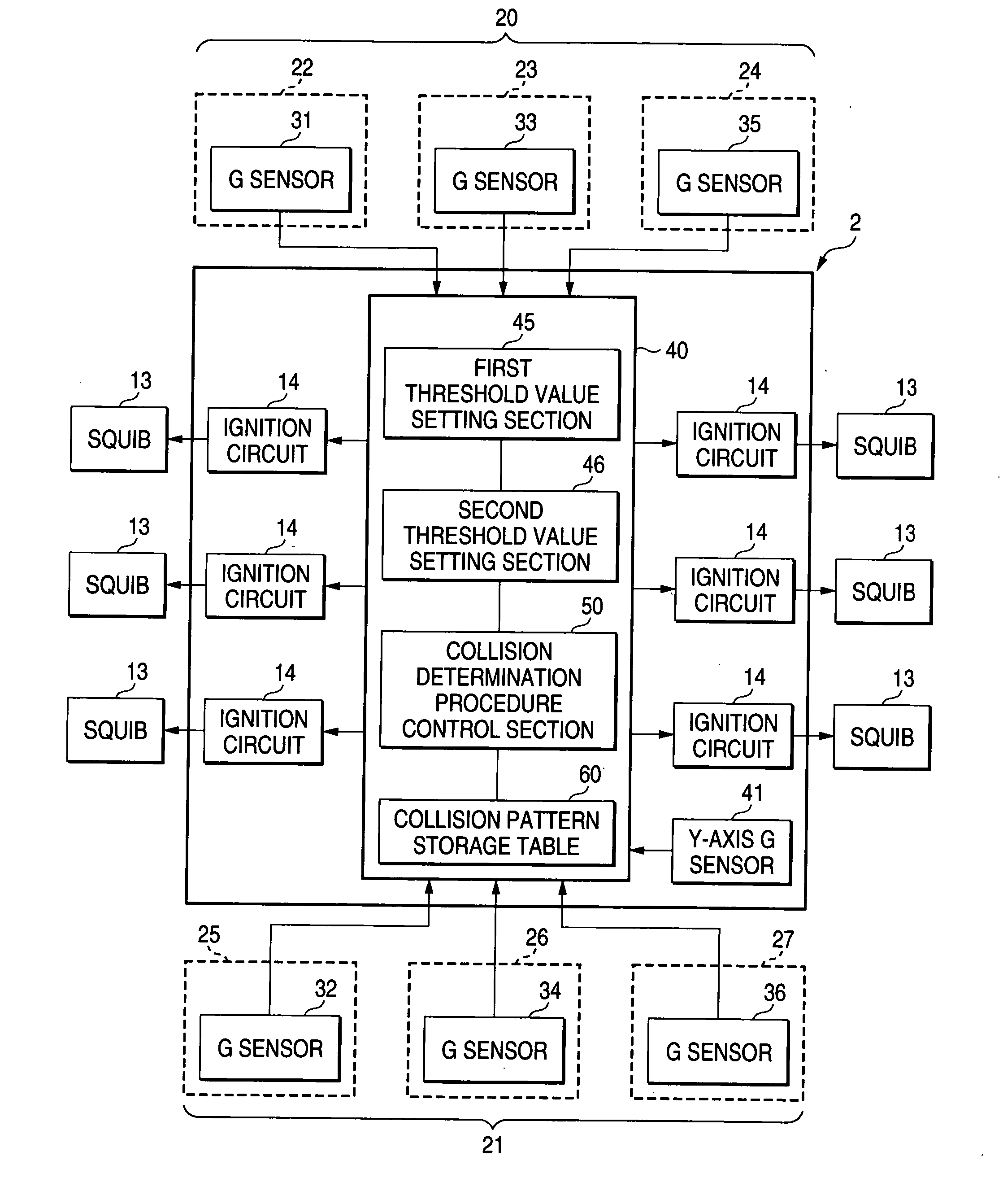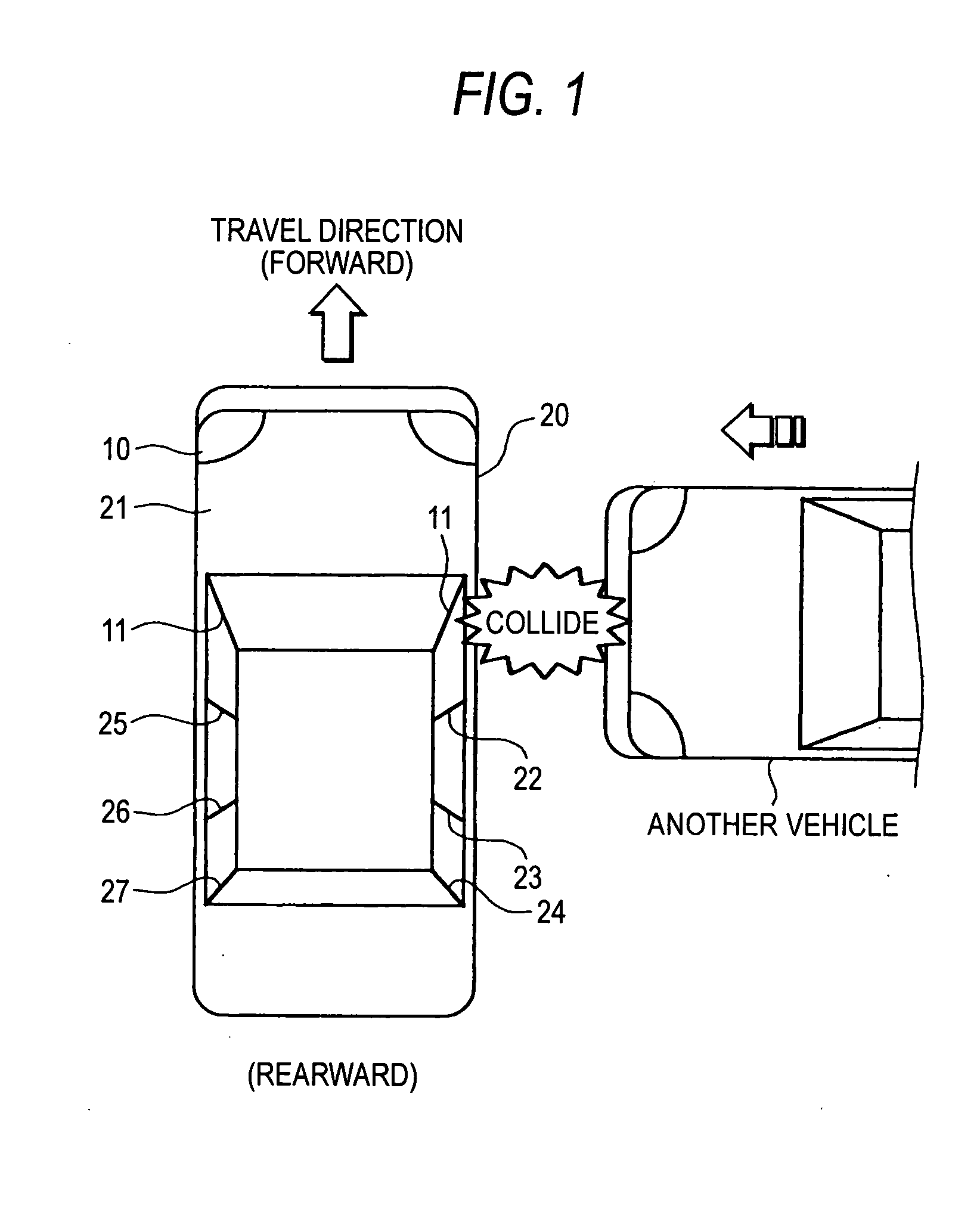Airbag apparatus
a technology of airbags and g sensors, which is applied in the direction of pedestrian/occupant safety arrangements, instruments, and tractors, etc., can solve the problems of airbag apparatus, ecu may not be able to process the g level values from the g sensor disposed, and the ecu is imposed on loads, so as to reduce the time required to determine the occurrence of collisions
- Summary
- Abstract
- Description
- Claims
- Application Information
AI Technical Summary
Benefits of technology
Problems solved by technology
Method used
Image
Examples
first embodiment
[0039] As shown in FIGS. 1 and 2, the airbag apparatus includes a plurality of G sensors 31 to 36 (side-impact sensors) for detecting a lateral collision, at predetermined positions (on the right and left sides) of a vehicle 10. An airbag controller 2 (FIG. 3) predicts a collision direction (collision position) of collision with another vehicle on the basis an integral value (G integral value) of acceleration values output from the respective G sensors 31 to 36. The airbag controller 2 performs processing of shortening the sampling period of G sensors disposed in the predicted collision direction (predicted collision portion) or performs processing of giving a preference in the sampling order to the sampling of the G sensors disposed in the predicted collision direction (predicted collision portion). Consequently, by virtue of the above, in addition to detecting collision direction of a collision with another vehicle prior to the collision, the airbag apparatus according to the embo...
second embodiment
[0060] Next, a second embodiment of the invention will be described in detail with reference to FIG. 7. In the first embodiment, a collision direction (on the right side surface 20 or on the left side surface 21) of a collision with another vehicle is determined (predicted) on the basis of integral values of acceleration values output from the plurality of G sensors, and the sampling period for the G sensors located in the thus-determined (predicted) collision side is shortened. However, in the second embodiment, the collision-position prediction section 53 (FIG. 4) specifies a collision portion of collision with another vehicle; and the sampling period of only the G sensor located at the collision position specified by the collision-position prediction section 53 is shortened.
[0061] More specifically, as shown in the flowchart shown in FIG. 7, the ECU 40 integrates acceleration values output from the plurality of G sensors 31 to 36 subsequently (step S210). Then, the integral-valu...
third embodiment
[0064] Next, a third embodiment of the invention will be described in detail with reference to the flowchart shown in FIG. 8. In the respective embodiments shown in FIGS. 8 to 25 below, detailed descriptions of the same processes as those in the hitherto-described flowchart shown in FIG. 5 will be omitted.
[0065] In the hitherto-described first and second embodiments, a collision direction (on the right side surface 20 or on the left side surface 21) or a collision position of a collision with another vehicle is determined (predicted) on the basis of G level values (G integral values) detected by the plurality of G sensors, and the sampling period of the plurality of G sensors located in the thus-determined predicted-collision side or only the G sensor located at the collision-predicted portion is shortened (0.5 ms→0.25 ms). However, in the third embodiment, the sampling-sequence control section 56 causes the plurality of G sensors located in the collision direction, which has been ...
PUM
 Login to View More
Login to View More Abstract
Description
Claims
Application Information
 Login to View More
Login to View More - R&D
- Intellectual Property
- Life Sciences
- Materials
- Tech Scout
- Unparalleled Data Quality
- Higher Quality Content
- 60% Fewer Hallucinations
Browse by: Latest US Patents, China's latest patents, Technical Efficacy Thesaurus, Application Domain, Technology Topic, Popular Technical Reports.
© 2025 PatSnap. All rights reserved.Legal|Privacy policy|Modern Slavery Act Transparency Statement|Sitemap|About US| Contact US: help@patsnap.com



